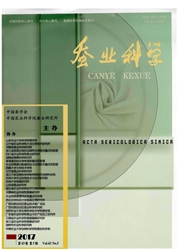

 中文摘要:
中文摘要:
同源异型结构域蛋白(homeobox,HOX)基因是对生物体的生长发育从时间和空间上进行调控的一类基因。Vis(vismay)属于同源异型结构域蛋白转化生长影响因子(transforming growth interacting factor,TGIF)家族成员,在脊椎动物的研究中表明TGIF是转化生长因子-β(transforming growth factor β,TGF-β)信号转导途径中的转录抑制子,但在果蝇(Drosophilamelanogaster)的研究中发现其是一种转录激活子。基于为探究家蚕(Bombyx mori)中vis基因的功能提供基础信息的目的,在电子克隆的基础上通过RT-PCR从家蚕5龄幼虫精巢cDNA中克隆了长度为847 bp的vis基因(Bmvis)片段(GenBank登录号:JF412700)。蛋白结构分析表明Bmvis在HOX结构域的螺旋区和TALE区段内高度保守,同时在HOX结构域外的C末端大约20个氨基酸也是高度保守的。进化分析显示昆虫的Vis与Achi(achintya)聚为一类,但Vis与Achi根据物种分类关系聚在一起。对Bmvis在家蚕5龄第3天幼虫组织中表达的RT-PCR检测显示其仅在精巢中表达。将Bmvis进行原核表达后获得抗Bmvis多克隆抗体,亚细胞定位显示Bmvis在细胞核和细胞质中均有表达,但主要分布在细胞核中。
 英文摘要:
英文摘要:
Homeobox genes have been identified in diverse organisms which regulate multiple developmental processes temporally and spatially.Vis(vismay) belongs to the transforming growth interacting factor(TGIF) superfamily of which members are homeodomain proteins and are transcriptional repressors in transforming growth factor β(TGF-β) signaling pathway in vertebrates,while in Drosophila melanogaster TGIFs are considered as transcriptional activators.In order to provide fundamental information for exploring the function of vis gene in silkworm(Bombyx mori),an 847 bp fragment of Bombyx mori vis gene(Bmvis,GenBank accession No.JF412700) was cloned from testis cDNAs of the 5th instar silkworm larvae by RT-PCR based on in silico cloning.Protein structure analysis indicated that helical regions of HOX domain and TALE domain were highly conserved in BmVis,and that the 20 amino acid residues at the C terminal outside the HOX domain were highly conserved as well.Phylogenetic analysis demonstrated that the Vis and Achi(achintya) from insect were grouped into one cluster,yet the Vis and Achi were clustered according to the classification relationship of different species.Expression pattern analysis showed that Bmvis was only detected in testes in day 3 larvae of the 5th instar.Subcellular localization using anti-BmVis polyclonal antibody which was prepared from prokaryotic expression showed that Bmvis was expressed in cytoplasm and nucleus,but was mainly distributed in nucleus.
 同期刊论文项目
同期刊论文项目
 同项目期刊论文
同项目期刊论文
 SHOTGUN PROTEOMIC ANALYSIS OF WING DISCS FROM THE DOMESTICATED SILKWORM (BOMBYX MORI) DURING METAMOR
SHOTGUN PROTEOMIC ANALYSIS OF WING DISCS FROM THE DOMESTICATED SILKWORM (BOMBYX MORI) DURING METAMOR Effect of inhibiting the expression of insulin-like peptide gene BBX-B8 on development and reproduct
Effect of inhibiting the expression of insulin-like peptide gene BBX-B8 on development and reproduct Alternative splicing, expression patterns and promoter characters of vasa-like gene from the silkwor
Alternative splicing, expression patterns and promoter characters of vasa-like gene from the silkwor Effects of BmKIT 3R gene transfer on pupal development of Bombyx mori Linnaeus using a Gal4/UAS bina
Effects of BmKIT 3R gene transfer on pupal development of Bombyx mori Linnaeus using a Gal4/UAS bina Characterization of the complete genome segments from BmCPV-SZ, a novel Bombyx mori cypovirus 1 isol
Characterization of the complete genome segments from BmCPV-SZ, a novel Bombyx mori cypovirus 1 isol Elementary research of the formation mechanism of sex-related fluorescent cocoon of silkworm, Bombyx
Elementary research of the formation mechanism of sex-related fluorescent cocoon of silkworm, Bombyx 期刊信息
期刊信息
